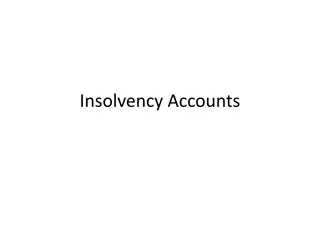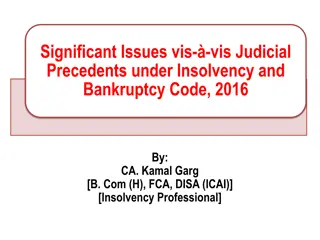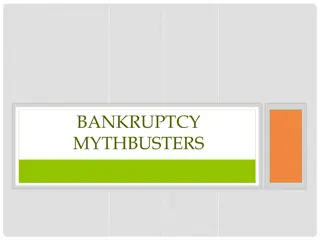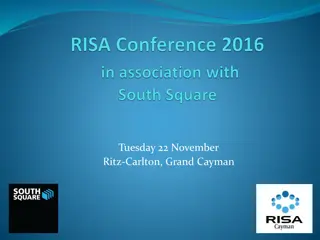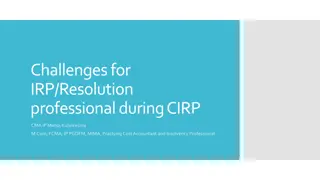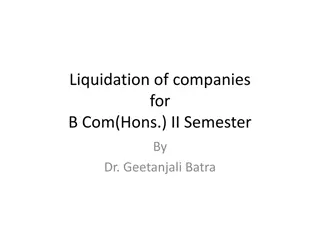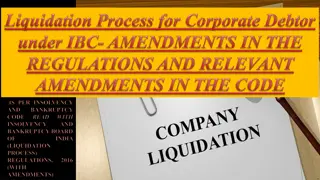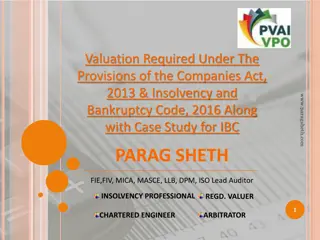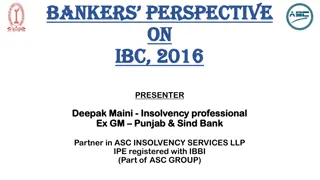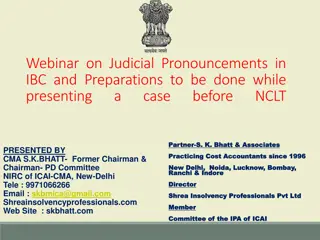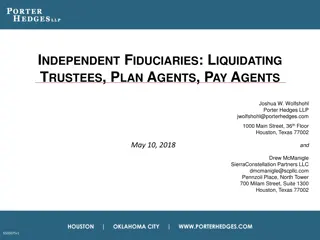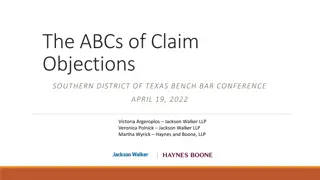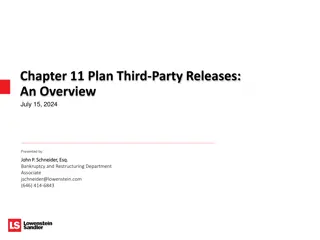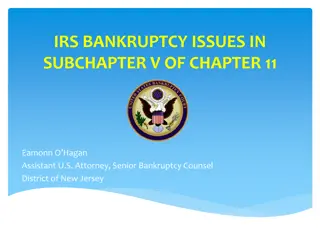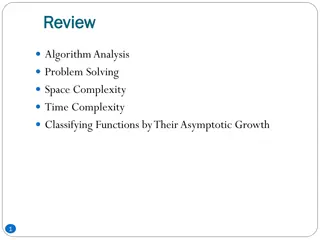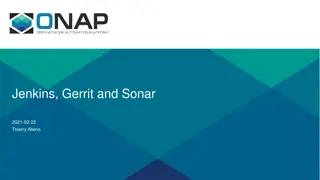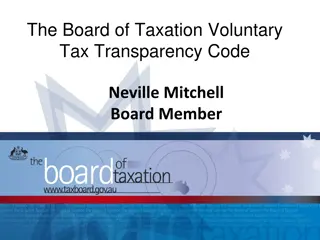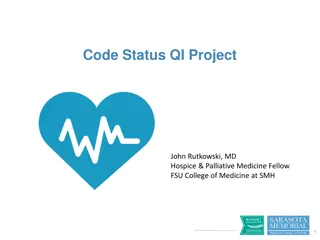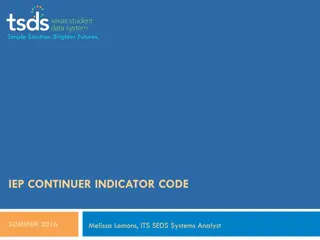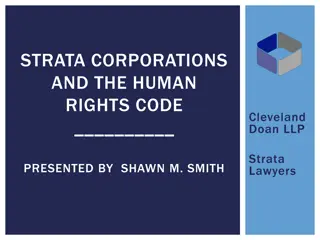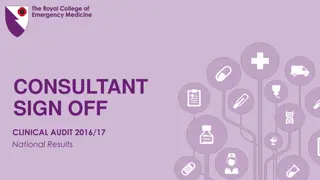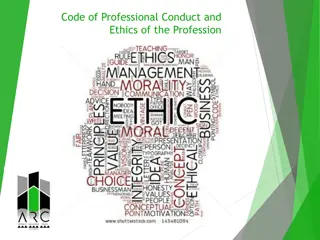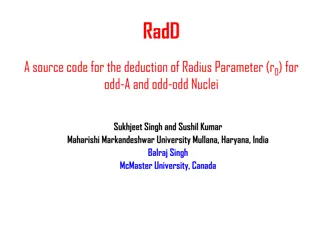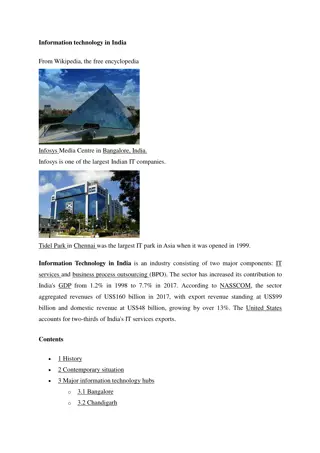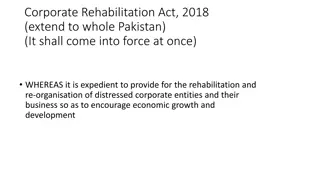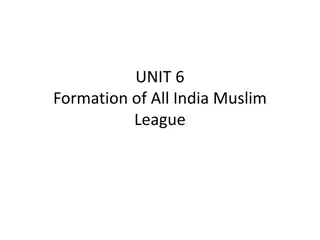Understanding the Insolvency and Bankruptcy Code of 2016 in India
The Insolvency and Bankruptcy Code of 2016 in India replaced various existing laws to streamline the process of corporate restructuring, insolvency, and liquidation. Enacted to resolve bad debts efficiently, attract investors, and strengthen the economy, the code offers benefits like quicker resolution of non-performing assets and a fresh start for entrepreneurs. It applies to companies, LLPs, partnership firms, and individuals facing insolvency or liquidation.
Download Presentation

Please find below an Image/Link to download the presentation.
The content on the website is provided AS IS for your information and personal use only. It may not be sold, licensed, or shared on other websites without obtaining consent from the author. Download presentation by click this link. If you encounter any issues during the download, it is possible that the publisher has removed the file from their server.
E N D
Presentation Transcript
Insolvency & Bankruptcy Code, 2016 Gateway of Professional Opportunities for CMAs Dr. S. K. Gupta (Managing Director and Chief Executive Officer) Insolvency Professional Agency of Institute of Cost Accountants of India
KEY FACETS IBC-2016 was enacted to bring-in an umbrella law that shall encompass and accommodate the various fragmented and compartmentalized laws relating with corporate restructuring, insolvency and liquidation. The intent was to: ensure easy and timely resolution/ recovery of bad debts and claims instill confidence in institutional investor provide an opportunity of revival to sick/bankrupt entities by corporate restructuring strengthen the Indian economy on global platform and to attract FDI and FIIs
EARLIER INSOLVENCY REGIMES IN INDIA Prior to enactment of the Insolvency and Bankruptcy Code, 2016 (the Insolvency Code ) the existing framework was governed by:- The Companies Act, 1956 and the Companies Act, 2013; The Sick Industrial Companies (Special Provisions) Act, 1985; The Recovery of Debts Due to Banks and Financial Institutions ( RDDBFI ) Act, 1993; The Securitization and Reconstruction of Financial Assets and Enforcement of Security Interest ( SARFAESI ) Act, 2003; The Presidency Towns Insolvency Act, 1909 and the Provincial Insolvency Act, 1920; Regulations, directions, circulars, rules, notifications and guidelines of the Reserve Bank of India ( RBI ).
BENEFITS OF THIS CODE Previously, four different forums High Courts, Company Law Board (CLB), Board for Industrial and Financial Reconstruction (BIFR) and Debt Recovery Tribunal (DRT) had overlapping jurisdiction, which gave rise to systemic delays and complexities in the process. The code overcomes these challenges and would reduce the burden on the courts as all litigation will be filed under the code before the National Company Law Tribunal (NCLT) for corporate insolvency and insolvency of LLPs, and before DRT for individual insolvency and insolvency of unlimited partnership firms. The code could ensure quicker resolution of NPA problems. Bankruptcy laws accept that business ventures can fail and allow entrepreneurs to make a new start.
APPLICATION The provisions of this code shall apply to: (a) any company incorporated under the Companies Act, 2013 or under any previous company law; (b) any other company governed by any special Act for the time being in force. (c) any Limited Liability Partnership incorporated under the Limited Liability Partnership Act, 2008; (d) such other body incorporated under any law for the time being in force, as the Central Government may, by notification, specify in this behalf; and (e) partnership firms and individuals,in relation to their insolvency, liquidation, voluntary liquidation or bankruptcy, as the case may be.
WHY IS THE CODE AN IMPERATIVE TODAY 1. Improve Ease of Doing Business ranking for India. 2. The stressed assets in the Indian banking system have peaked at ~US$ 150 billion or over Rs 10 lakh crores (~15% of gross advances). 3. Heightened focus on the resolution of the problem by the Reserve Bank of India (RBI) and the Supreme Court. 4. There is a dire need of capital today not just for stressed companies but for growth in general. 5. Long time for resolution and recovery; Doing away with a fragmented framework. 6.Improve the confidence of the International investor in the debt market.
INSOLVENCY AND BANKRUPTCY CODE ECOSYSTEM IBB apex body for promoting transparency & governance in the administration of the IBC; will be involved in setting up the infrastructure and accrediting IPs & IUs. Insolvency and Bankruptcy Board (IBB) NCLT The Adjudicating Authority (AA) IUs - Centralised repository of financial and credit information of borrowers; would validate the information and claims of creditors vis- -vis borrowers, as needed. Insolvency Agencies Information Utilities (IUs) IPAs- professional bodies registered by the Board to promote and regulate the insolvency profession; these bodies will enrol Ips IPs- Licensed private professionals regulated by the Board; will conduct resolution process; to act as Liquidator/bankruptcy trustee; appointed by creditors and override the powers of board of directors. Insolvency Professionals (IPs) Adjudicating Authority (AA) - would be the NCLT for corporate insolvency; to entertain or dispose any insolvency application, approve/ reject resolution plans, decide in respect of claims or matters of law/ facts thereof. CoC- consists of financial creditors to who will appoint and approve actions of IPs Committee of Creditors (CoC) Insolvent entity
CORPORATE INSOLVENCY RESOLUTION PROCESS (CIRP) UNDER THE CODE Default min INR 1 lakh; even a single day Committee of creditors (CoC) Consists of excluding related parties To approve several actions of RP financial creditors only, Who can file the application? Financial & Operational creditors (including Government employees/workmen), Corporate debtor Resolution Professional (IRP/ RP) Financial creditor corporate applicant shall propose the name of an IRP in the application All powers of the board and management shall vest with the IRP/ RP Moratorium Moratorium shall prohibit: Institution of suits Transfer of assets Foreclosure, enforcement under SARFAESI Recovery of assets Resolution plan The resolution plan must provide for: payment of insolvency resolution process costs repayment of the debts of operational creditors management of the affairs of the borrower after the plan is approved implementation and supervision of the approved plan Voting power Only financial creditors have voting power in the committee in the ratio of debt owed All decision of the committee shall be approved by 75% of financial creditors & and and/ or recovery or Fast track insolvency For debtors as may be notified by the central government (completed in 90 days)
LIQUIDATION PROCESS UNDER THE CODE Reporting Preliminary report within 30 days from the date of the order; Progress report within 15 days after end of every period of 3 months from the date of order Insolvency and liquidation cost Insolvency cost include interim funding, cost of running the debtor as going concern (eg rent or salary of employees), cost of IP etc Liquidation cost include any cost incurred by liquidator liquidation period Secured creditor in liquidation Secured creditor has the option to: enforce and realise the security outside the Code, or relinquish its security interest and receive proceeds as defined in the priority of claim Distinction between different class of secured creditors (first vs second charge, fixed vs floating charge) not clarified Liquidation order Liquidation order will be passed if: CIRP ends Plan not submitted to NCLT Plan not approved Decided by CoC Plan not properly implemented Liquidation steps Appointment of liquidator Formation of liquidation estate No legal proceeding by or against the debtor Consolidation of claims Distribution of assets Dissolution of debtors (to be completed within 2 years) Liquidator Liquidator shall: Form liquidation estate take custody & control of all assets consolidate, verify, admit and determine value of creditors claims Carry on the business for its beneficial liquidation Priority Waterfall of claims Insolvency resolution process and liquidation costs Secured creditor & workmen dues (upto 24 months) Other employee dues (upto 12 months) Financial debts of unsecured creditors during Government dues (upto 2 years) and unpaid secured creditors Any remaining debts and dues Preference shareholders, if any rights of Equity shareholders or partners, as the case may be
OPPORTUNITIES FOR CMAS The IBC-2016 provides that CMAs, CAs, Company Secretaries & Advocates (having fulfilled certain eligibility criteria) can practice as Insolvency Professionals. Becoming an Insolvency Professional is one of the greatest and brightest professional opportunity that has come to the kitty of CMAs of recent as we are the best fit to the role and responsibilities expected out of an insolvency professional. Let s see how
MARKET OPPORTUNITY 1812 Insolvency Professionals as on 31st March 2018 76 Insolvency Firms 8457 cases pending with Tribunal as on Dec 2017 Rs 8410 bn Gross NPA of all banks Financial Creditors realized 215.11% over liquidation value. More Insolvency cases to come. ( Jan- March 2018) 701 cases admitted till 31st March. 525 437 361 228 167 156 141 128 79 65 37 36 23 8 1 Jan- March 2017 Apr-June 2017 July-Sep 2017 Oct- Dec 2017 Jan- Mar 2018 No of Cases Admitted Cases under CIRP Closed Insolvency and Bankruptcy Cases on the Rise- Opportunities for Finance Professionals
WHY BECOME AN INSOLVENCY PRACTITIONER? Insolvency is possibly the most demanding career option a professional can undertake. It is certainly one of the most challenging, involving and rewarding. Insolvency practitioners can find themselves running businesses, constructing and negotiating deals or investigating and advising on the viability of a business and its restructuring (and, sometimes, the integrity of its directors). The work of the insolvency practitioner affects the lives, prospects and livelihoods of both creditors and debtors. Insolvency work is as much about people as it is about figures. Insolvency practitioners need the skills to deal with creditors, anxious directors, concerned employees and a range of other stakeholders in the business. Insolvency practitioners need the skills to deal with creditors, anxious directors, concerned employees and a range of other stakeholders in the business.
WHAT MAKES A GOOD INSOLVENCY PROFESSIONALS? Practical working knowledge of : Cash flow management Company law Banking/ Finance Stake holder management Insolvency law Negotiation skills Valuation / Sale of assets Commercial and business Taxation
WHAT ARE THE TOP CHARACTERISTICS OF PROFESSIONALS IN INSOLVENCY PRACTICE? When it comes to competencies, insolvency uses client facing skills, advisory skills, maths and statistics, analysis, customer service and strategy. Here s a breakdown of the top characteristics of professionals in this industry: 1. Numbers A top insolvency professional should have good mathematic competency, as a large part of their role involves the preparation of accounting statements. 2. Law A large part of insolvency professionals have some form of law qualification or are academic or hard working enough to be able to read and interpret the laws which govern the an insolvency profession. 3. Report writing Insolvency professional is required to prepare various reports to a number of different stakeholders on various issues is increasing day by day. Therefore Report writing skills are very important.
WHAT ARE THE TOP 10 CHARACTERISTICS OF PROFESSIONALS IN INSOLVENCY PRACTICE? 4. Communication You must be a good communicator. This is mainly because, as an insolvency professional, you work with and for a number of different stakeholders. 5. Discreet and personable You must be able to keep the information you are given confidential and use the right wording in meetings with clients. This is vital, as brash or insensitive comments made in meetings with clients who are facing debt problems can cause upset even if it s unintended; not to mention it may cause damage to your reputation. 6. Commerciality Aside from advising clients purely based on the legal ramifications, you must also be mindful that the client will often weigh up their options based on how it affects them financially. Therefore being aware of commercial aspects is imperative. .
WHAT ARE THE TOP 10 CHARACTERISTICS OF PROFESSIONALS IN INSOLVENCY PRACTICE? 7. A quick learner If you choose to work in the insolvency profession, you have to be prepared to learn a lot in a short space of time. You must adapt to the ever-changing legislation and provide advice tailored to each client. 8. Thick-skinned One area of the profession which is sometimes experienced is dealing with irate stakeholders. You must have the confidence to provide your advice or comments with confidence or be personable enough to calm them down. This is generally experienced when dealing with creditors who have just found out that the company they supplied has closed and they are not going to be paid in full. 9. Sales skills This is an attribute which is useful, as an element of the insolvency role is to negotiate sales of businesses or assets.
OPPORTUNITIES AVAILABLE UNDER IBC-2016 As an interim resolution professional As a resolution professional As a liquidator As a valuer As an consultant/ accomplice/ assisting professional to the resolution professional
ROLES AND RESPONSIBILITIES OF INTERIM RESOLUTION PROFESSIONAL Manage operation of the corporate debtor as a going concern Public announcement Appointment of registered valuers Collection / Collation /verification and determination of claims Constitute a committee of creditors Holding first meeting of C o C Preparation of partial information memorandum Take immediate custody and control of all the assets Monitor assets of the corporate debtor Determine financial position of corporate debtor Collect all information relating to the assets, finances and operations of the corporate debtor
ROLES AND RESPONSIBILITIES OF RESOLUTION PROFESSIONAL Conduct entire C I R P Manage the operations of corporate debtor Preserve and protect the assets of the corporate debtor including continued business operations Represent and act on behalf of the corporate debtor including Court cases Raise interim finances subject to the approval of the C o C Update list of claims Prepare information memorandum Invite prospective lenders, investors, and any other person to put forward resolution plans Providing access of information to resolution applicant Check resolution plan for compliance with the code & present to C o C. Submit resolution plan approved by C o C to N C L T Send copy of order of N C L T approving/rejecting resolution plan to participants and resolution applicants
ROLES AND RESPONSIBILITIES OF LIQUIDATOR T o receive , collect and verify claims of all the creditors T o take into custody / control and evaluate all the assets, property, effects and actionable claims of the corporate debtor- protect and preserve the assets & properties. Form and hold liquidation estate as a fiduciary for the benefits of the creditors Carry on business for beneficial liquidation as necessary Sell movable and immovable properties by auction/ private contract Obtain professional assistance T o institute or defend suit Investigate financial affairs of C D for undervalued/ preferential transactions Apply to N C L T for orders and directions as required Prepare preliminary report, assets memorandum, sale report etc Maintain relevant records Realize and distribute
ROLE AS A VALUER The Code mandates appointment of two valuers for ascertaining the value of the estate of the debtor. The valuers have to determine the liquidation value of the assets of the corporate debtor. CMAs do possess good knowledge of valuation. Further, the Institute has also been offering specialized advanced courses in valuation for creating experts in this area .
SCOPE FOR OTHER ROLES UNDER IBC FOR C M As Forensic Audit : IBC provides for look back period of 2 years in case of related parties and 1 years in case of other parties. It might be needed to conduct an forensic audit in some matters wherein CMAs can provide professional services. Due Diligence : As per code IRP need to collect all information relating to the assets, finances and operations of the corporate debtor for determining the financial position of the corporate debtor, including information relating to (i)business operations for the previous two years; (ii) financial and operational payments for the previous two years; (iii) list of assets and liabilities as on the initiation date; and (iv)such other matters as may be specified;
SCOPE FOR OTHER ROLES UNDER IBC FOR CMAs Data processing : As per IBC code IRP and RP are needed to collate and verify claims of the creditors. In a large operating company data could be huge. IRP/RP may avail services of practicing C M As for data processing Management of borrower : IRP/RP are required to manage business of the borrower on a going concern basis. IRP/RP may engage C M As for assisting in management e.g. as CFO Secretarial and legal work : CIRP process requires huge amount of book keeping, holding of meeting, recording minutes, communication with N C L T etc. IP may take help of CMAs in this regard. Representing lenders : Any creditor who is part of C O C are allowed to appoint other IP (other than RP) as their representative in COC. . Representing before NCL T / NCLA T : A party to any proceeding or appeal before the Tribunal or the Appellate Tribunal, as the case may be, may either appear in person or authorize one or more professionals to present his case before the Tribunal or the Appellate Tribunal.
SCOPE FOR OTHER ROLES UNDER IBC FOR CMAs Stock Audit : Most corporate Debtors enjoy working capital limits. It may be necessary to conduct periodic Stock Audit of the C D during the CIRP process. Internal / Concurrent Audit : RP can appoint Internal / Concurrent Auditors during the business under CIRP. Monitoring and Supervision of Resolution Plan : IBC requires provision of Monitoring and Supervision of Resolution Plan after its approval by NCL T during its period. CMAs can provide services of such monitoring and supervision.
THE CHALLENGES While there are opportunities galore for resolution professionals, they are not without significant challenges. As the main pillar of the new law is time-bound resolution of bankruptcy cases, these professionals have to accomplish a very big feat within a strict timeline of 180 days. The challenge for the IP is to manage the company as a going-concern without diminishing its value, and come up with a resolution plan within 180 days. Also, taking over a company and running it like a going concern is easier said than done. Imagine an IP with no prior experience of working with a steel company may be roped in for a project involving a debtor which is a steel manufacturer. How is he supposed to run a company without understanding the business of the company? He doesn't have the luxury of time as well because he has to also simultaneously work on a resolution plan, conduct meetings of the creditors committee as well as raise interim finance for the company.
THE CHALLENGES There are other practical issues. There is every chance that the management and staff of the borrower against which the insolvency proceeding has been started does not cooperate with the IP and don't provide information and documents necessary for running the company or preparing a resolution plan. They may face situations where the promoter of the debtor would try to stop them from entering the premise, forget about giving access to all documents and books of accounts.
HOW CMAS FIT IN.OUR STRENGTHS We are trained auditors. CMAs possess a unique blend of core competencies in accounting, management and strategy. We have expertise in the field of risk assessment, valuation, financial and corporate restructuring and financial reporting that is what the law is all about We have an experience in consultancy and client management . CMAs are well positioned to grab the opportunities offered by IBC
IPA Institute of Cost Accountants of India The Insolvency Professional Agency of Institute of Cost Accountants of India (IPA ICAI), a section 8 company incorporated under the Companies Act 2013 has been promoted by the Institute of Cost Accountants of India to enrol and regulate Insolvency Professionals (IPs) as its members in accordance with provisions of the Insolvency and Bankruptcy Code 2016, Rules, Regulations and Guidelines issued thereunder.
Eligible Criteria Registration after passing Examination Regulation 5 of the Insolvency and Bankruptcy Board of India (Insolvency Professionals) Regulations, 2016 , subject to the other provisions of these Regulations, an individual shall be eligible for registration, if he- has passed the National Insolvency Examination; has passed the Limited Insolvency Examination, and has fifteen years of experience in management, after he received a Bachelor s degree from a university established or recognized by law; or has passed the Limited Insolvency Examination and has ten years of experience as - o a chartered accountant enrolled as a member of the Institute of Chartered Accountants of India, o a company secretary enrolled as a member of the Institute of Company Secretaries of India, o a cost accountant enrolled as a member of the Institute of Cost Accountants of India, or o an advocate enrolled with a Bar Council.
Thank You E Mail: ceo@ipaicmai.in Mobile: 9810162341


